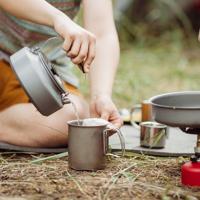When setting out on a camping adventure, one of the crucial elements to consider is how to stay hydrated responsibly. Reusable water bottles come in as a sustainable solution for campers who are mindful of both their health and the environment.
Why Choose Reusable Water Bottles?
Reusable water bottles contribute to sustainability by reducing single-use plastic waste. Over 1 million plastic bottles are bought around the world every minute, as noted by National Geographic. Choosing reusable options can make a difference in curbing plastic pollution.
These bottles are often made from durable materials like stainless steel, glass, or BPA-free plastic, offering longevity compared to single-use options. Not only are they durable, but they also ensure that you avoid the potential toxins found in some disposable bottles.
Types of Reusable Water Bottles
Stainless Steel
Stainless steel bottles are known for their durability and temperature regulation. They can keep water cold for hours, a crucial benefit in the warm months of camping. Brands like Hydro Flask and Yeti have popularized double-walled vacuum insulated bottles, which are gaining popularity for their functional attributes.
Glass
Glass water bottles are favored by some for their purity and taste. They do not impart flavors and are easy to clean. Brands like Lifefactory provide silicone sleeves for their glass bottles to help prevent breakage.
BPA-Free Plastic
For campers seeking a lightweight option, BPA-free plastic bottles are a great choice. Nalgene bottles are well-known for camping; they are robust and light enough to carry on long trails.
Choosing the Right Reusable Water Bottle
When selecting a water bottle for your camping trips, consider these factors:
- Capacity: Depending on the length of your trip and the availability of fresh water sources, choose a bottle size that meets your hydration needs.
- Weight: Opt for a lighter bottle if you are planning on longer hikes or backpacking.
- Insulation: If you want to maintain the temperature of your beverages, consider a double-walled insulated bottle.
- Durability: Consider the material and design to ensure it can withstand potential falls or rough conditions.
Caring for Your Reusable Water Bottle
Taking care of your bottle ensures its longevity and safety. Most bottles are dishwasher safe, but always check the manufacturer’s instructions. Regular cleaning helps prevent the buildup of bacteria, especially important after storing beverages other than water.
You can use a mixture of vinegar and baking soda or a dedicated bottle-cleaning brush for deep cleaning.
Benefits Beyond Hydration
Carrying a reusable water bottle also cultivates mindfulness. It encourages regular hydration and reduces the dependence on external water sources that might not be as eco-friendly or safe. Moreover, it serves as a visual reminder of the sustainable commitment you’ve chosen to uphold.
Choosing a reusable water bottle is a simple step, yet it significantly influences our environmental footprint, especially in the naturally delicate settings of the great outdoors. Whether you’re a seasoned camper or a weekend explorer, the reusable water bottle stands as a testament to practical and sustainable innovation in camping gear.




